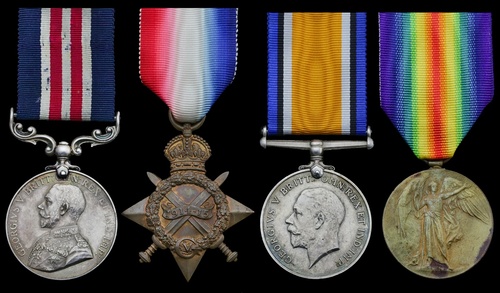
Auction: 20001 - Orders, Decorations and Medals - conducted behind closed doors
Lot: 676
(x) An M.M. group of four awarded to Sergeant A. Gafney, East Kent Regiment, who was likely decorated for gallantry on the opening day of the Third Battle of the Scarpe, an 'unmitigated disaster' for the British Army which suffered nearly 6,000 men killed for little material gain
Military Medal, G.V.R. (1298 Sjt: A. Gafney. E. Kent R.); 1914-15 Star (G-1298 Sjt. A. Gafney. E. Kent R.); British War and Victory Medals (G-1298 Sjt. A. Gafney. E. Kent R.), staining and minor patches of verdigris to last, nearly very fine (4)
M.M. London Gazette 18 July 1917.
Alfred Gafney was born in 1895 at Enfield, the eldest son of John Richard Gafney of 117 Bush Hill Park, Percival Road, Enfield, London. A Post Office clerk by profession, Gafney attested for the East Kent Regiment at St. Pancras on 8 September 1914, being sent to Canterbury Depot for training. Appointed Lance Corporal on 17 September 1914 and Corporal a week later, he was further promoted Sergeant on 2 March 1915 before serving in France and Flanders from 28 July 1915 with the 7th Battalion, East Kent Regiment.
The 7th Battalion were heavily engaged during the first day of the Battle of the Somme, being tasked to capture objectives on Montauban Ridge. On 4 July 1916 they captured Bronfay Farm before advancing to Celestines Wood on 7 July and assisting with the capture of Trônes Wood on 13 July. This feature was renowned for its dense undergrowth which heavily limited movement and made it difficult to maintain direction. Intense German shellfire had brought down the trees which in turn became entangled with barbed wire and strewn with the bodies of the dead. As a result, the men of the 7th Battalion became lost for a time, their plight exacerbated by the lack of reinforcements from the 7th Battalion of the Queen's (Royal West Surrey) Regiment who were pinned down by machine-gun fire 100m from the forest edge and later forced to retreat.
Advancing to Meaulte on 18 July 1916 and Hedauville on 25 September, the Battalion saw extensive action two days later at a crossroads near the village of Authille, affectionately known by the men as 'Crucifix Corner'. They subsequently took part in the attacks on Regina and Desire Trenches on 16 and 18 November before a period of rest in the new year, punctuated by parades and the presentation of ribbons for gallantry (The War Diary for the 7th Battalion, East Kent Regiment, refers). Sent to billets at Bethune and Marest in March 1917 for further training, the men returned to the front line on 1 May 1917 when sent to bivouacs in trenches northeast of Neuville Vitasse.
The Third Battle of the Scarpe
At 03.45am on 3 May the 7th Battalion launched a major assault on the German trenches towards Cherisy. Advancing in pitch darkness the men became disorientated and casualties from enemy fire mounted as they headed towards their first objective - a line drawn between Triangle Wood and the location of present-day St. Michael's statue:
'Time 9.35am. Situation of 54th Infantry Brigade still obscure; they have not reached the Blue Line.
At about 11am reports were received that a general retirement was taking place, and it soon became apparent that the whole line was coming back. The enemy established an intense bombardment on our front trench system and of the valley in rear, and his machine gun fire was heavy. Cable Trench was by this time full of men in addition to 'D' Company, 7th Buffs, but owing to the fact that the enemy and our troops were hopelessly intermingled, it was impossible to fire on the enemy.'
Casualties for the Battalion during operations on 3 and 4 May 1917 numbered 12 officers and 368 men killed, wounded or missing. According to the Official History, Military Operations France and Belgium 1917 by author Cyril Falls, the fighting was nightmarish, terrifying and bloody, the failure heavily attributed to:
'the readiness with which the German infantry yielded to the first assault and the energy of its counter-attack; and, it must be added the bewilderment of the British infantry on finding itself in the open and its inability to withstand any resolute counter-attack.'
Having survived this period of intense fighting, Gafney returned to Depot at Canterbury on 10 May 1917, being gazetted the Military Medal a couple of months later. He was discharged Class 'Z' on 2 February 1919 and returned to his former career with the Post Office; sold with copied service record, war diary extract and MIC.
Subject to 5% tax on Hammer Price in addition to 20% VAT on Buyer’s Premium. For more information please view Terms and Conditions for Buyers.
Sold for
£380
Starting price
£270




